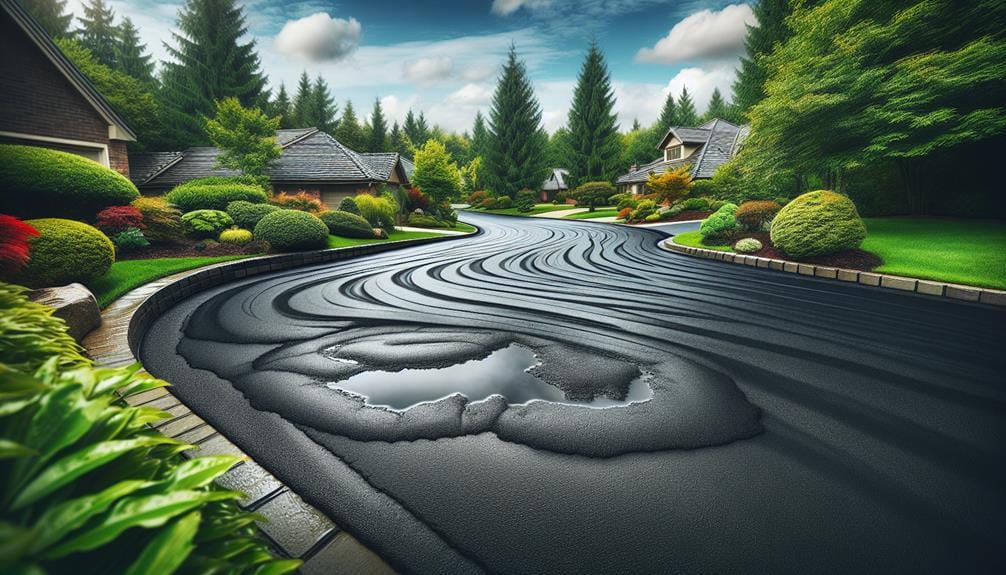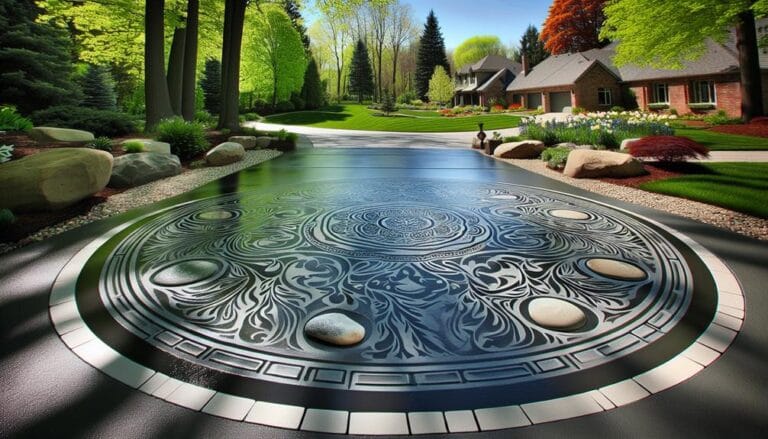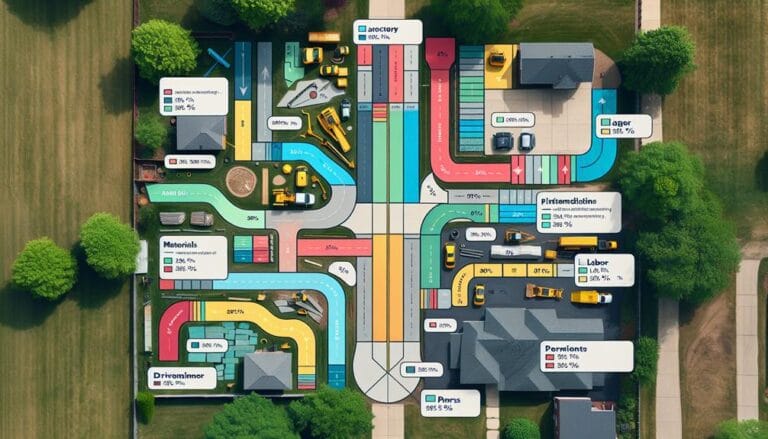What to Consider for Driveway Sealing?
When sealing our driveways, we need to take into account a few essential factors. First, we thoroughly clean the surface to remove any dirt, debris, or obstructions. Specific treatments are required for oil stains as part of this process. Filling cracks and potholes guarantees a smooth surface before sealing. Choosing the right sealant, with factors such as compatibility, UV resistance, and durability, is critical. We also need to think about the best season to apply the sealant, as temperature and weather conditions affect its performance. Regular sealing maintenance protects the driveway from damage, enhancing its appearance and increasing its lifespan.
Key Takeaways
- Thorough surface cleaning is essential to ensure effective adhesion of the sealer.
- Compatibility with driveway material and evaluation of performance features are crucial in selecting a sealant.
- Temperature fluctuations impact sealant performance; selecting seasonal-specific sealants is necessary.
- Regular sealcoating prevents damage and extends the lifespan of the driveway.
Preparation Before Sealing
Before we begin sealing our driveway, it's vital to thoroughly prepare its surface to secure a successful application. This involves a series of steps designed to guarantee the sealer adheres properly. Surface cleaning is a key initial step, removing dirt, debris, and other obstructions that could hinder the sealing process. This includes clipping and removing any overgrown grass along the edges and treating oil stains. Additionally, it's important to fill in any cracks and potholes, using specialized materials to guarantee a smooth surface. Wire brooms and blowers can be used to clean out dirt, weeds, and debris from the cracks, followed by an asphalt repair mix to fill them in.
Once the surface is clean and even, we can proceed with the sealing process. It's also significant to verify the driveway is completely dry, as any moisture can compromise the sealer's adhesion. We may need to power wash the entire area to achieve this. By following these steps, we can confirm that our driveway is well-prepared for sealing, providing maximum protection against the elements and preserving its appearance.
Choosing the Right Sealant
With a well-prepared driveway in hand, we can now proceed to selecting the most suitable sealant that will protect and enhance our driveway's appearance. The right sealant is vital in extending the life of our driveway. We need to take into account the different types of sealants available, including asphalt-based, acrylic-based, and epoxy-based options. Each type has its strengths and weaknesses, and we must choose the one that best fits our specific driveway needs.
We also need to contemplate surface compatibility. Not all sealants work well with all driveway materials. For instance, some may be better suited for asphalt driveways, while others may perform better on concrete. It is important to check the sealant's compatibility with our driveway's material to guarantee a strong bond and peak performance.
Additionally, we should evaluate the specific performance features we need in a sealant. Do we need UV resistance? Protection against oil stains or water damage? Different sealants offer varying levels of durability, flexibility, and resistance to multiple factors. By reflecting on these factors, we can choose the right sealant that will effectively shield our driveway and maintain its appearance.
Applicability in Different Seasons
As we select a sealant for our driveway, we need to contemplate how effective it will be across different seasons to guarantee year-round protection and appearance enhancement. The temperature fluctuations during different seasons considerably impact the performance of a sealant. For instance, during the winter months, we need a sealer that can withstand cold temperatures and prevent water infiltration that could cause damage. In contrast, during the summer months, we need a sealer that can resist heat and prevent cracking or wear from UV rays.
When considering the seasonal impact, it is vital to choose a sealant suitable for our specific climate and weather patterns. Sealcoating in the spring and summer months is ideal as the warm temperatures help cure the sealant quickly. For some sealers, it is important to apply them in temperatures above a certain threshold, such as 50 degrees Fahrenheit, to make sure they bond well and achieve the best results. Additionally, if we live in areas with extreme seasonal changes, we may need to adjust the frequency or type of sealant we use to maintain the driveway's integrity. This careful consideration will make certain our driveway remains protected and aesthetically pleasing throughout the year.
Importance of REGULAR Maintenance
Sealcoating your driveway regularly is crucial to guarantee the longevity and visual appeal of your property, as it prevents damage from weather elements and usage patterns. Regular maintenance is inarguably essential to ascertain that your driveway remains in good condition and looks great.
Here are some compelling reasons:
- Cost Savings
- Sealcoating can protect your driveway from damage, reducing the likelihood of expensive repairs down the line.
- Aesthetic Enhancement
- Regular sealing helps maintain the appearance of your driveway, enhancing the overall curb appeal of your property.
- Extended Lifespan
- Sealcoating your driveway regularly extends its lifespan, saving you from needing to replace it sooner.
Benefits OVER Alternative Materials
Compared to other materials, choosing asphalt for our driveway has several long-term benefits, especially when it is properly sealed. We find that asphalt offers a cost-effective solution compared to alternatives like concrete or pavers. While the initial cost of installation might be similar, the long-term maintenance necessities of these materials greatly surpass that of asphalt. For instance, sealing an asphalt driveway can extend its lifespan considerably, often by 20 to 30 years, whereas other materials require more frequent repairs and replacements, adding to their overall cost.
Another important factor to evaluate is the longevity of these materials. Asphalt, when properly sealed, can resist wear and tear caused by UV rays, snow, oil, and other chemicals, ensuring a longer lifespan. In contrast, other materials are more susceptible to damage from these elements and often need more extensive repairs. As a result, selecting asphalt for our driveway and ensuring regular sealing is an intelligent choice regarding both cost comparison and longevity factors.
Frequently Asked Questions
Does Sealcoating Fix Structural Problems Like Potholes and Cracks?
When we ask if sealcoating fixes structural problems like potholes and cracks, the answer is no. Sealcoating benefits by offering a protective layer, but it is not a substitute for proper crack repair and pothole filling.
Can I Apply Sealer by Spraying or Only by Brushing and Squeegeeing?
"We've noticed our neighbors' well-maintained driveways and wondered if we can apply sealer by spraying. Nope, for a thorough seal, we rely on the trusty brush technique and squeegeeing for a smooth finish."
Must I Immediately Address Alligator Cracks Before Sealcoating?
Before sealcoating, we must first address alligator cracks to prevent further damage. This involves repairing the cracks, then using sealing techniques like spraying, brushing, or squeegeeing to guarantee a long-lasting, even finish.
Can Sealcoating Be Done in Rainy Weather?
'Riding the waves of weather uncertainty, we ponder: can sealcoating be done in rainy weather? Unequivocally, no. Sealcoating demands ideal temperature and low humidity for effective adhesion and curing – it's not a rainy day adaptability test.'
How Long Must I Avoid Driving on Freshly Sealed Surfaces?
'For us, it's essential to wait at least 12 hours, ideally 24 to 48 hours, for the sealcoat to dry and cure, especially if the surface temperature is between 50°F and 120°F.'






